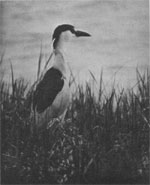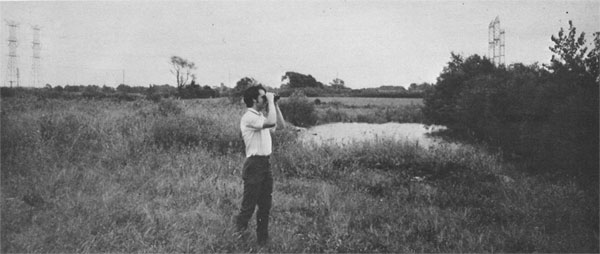NAL Site is Bird Haven
(The following article was written by Dave Carey, of Experimental Facilities, who, with his wife, Janet, spend much of their leisure time "bird-watching" on the NAL site.)
Just to the east of the Village lies an area where, in the course of a year, one can observe many species of both water and song birds. This area starts with a row of trees on the north, and includes an evaporation pond and large swampy region. It then follows a stream which crosses Batavia Road near the Lab entrance, and includes several more ponds south of the road.
In the Spring the ponds are a stopping point during migration for several kinds of waterfowl. Each species will arrive at a certain time, be seen for several days, and then disappear until Fall. Several days later, another species will arrive and do the same. This past Spring we hosted Canada Geese, Mallards, Gadwalls, Shovelers, Blue-Winged Teal, Ring-Necked Ducks, lesser scaup and common Goldeneye. The Wood Duck nests in trees and stays here all summer. After them the most eye-catching are perhaps the Goldeneye, with a large white circular spot on the side of the head.
Herons can be seen all summer in the swampy area and the ponds south of Batavia Road. If one ventures near the swamp north of Batavia Road the chances of flushing out a green heron are excellent. It is the smallest heron on site, about 14" high. One can identify it by its russet neck, spotted on the front, and its bright yellow legs which it holds behind as it flies away. Blackcrowned night herons are larger and often fly out of the area at dusk to feed. The most spectacular are the great blue herons which are very slender and reach a height of four feet. All three herons are found in the pond near the Lab entrance within sight of Batavia Road. However, it is advisable to stay in your car lest they all fly away.
Sandpipers are abundant in the swampy area. Here one can find solitary, spotted, pectoral, and semi-palmated sand pipers and lesser yellow legs. A closely-related bird seen throughout the Village is the Killdeer. It has a white head and brownish back and may be identified by the two black bands around its neck and a thin white stripe running the length of the wing, visible during flight. They are famous for their broken wing act when their nests are endangered.
If one is fortunate, one can find other water birds, such as king-fishers, sora, cools, and gallinules. Gallinules nest in the area. They are shaped somewhat like a chicken and have black backs with bright red beaks and a voice which sounds like a bicycle horn. For several weeks in the spring, black terns are seen skimming over the surface of the evaporation pond. Songbirds are abundant in the trees and underbrush at the edge of the swamp and ponds. Late in the summer the cedar waxwing with its crest and exotic coloration is in great profusion. Kingbirds are often seen chasing other birds many times their size. They are dark birds, with white throats and breasts, a small crest and a white bank at the tip of the tail. Several species of swallow are found perching on wires near the area and flying above the water searching for insects. Also seen are many others including cardinals, goldfinches, and bobolink.
To date, 57 species have been counted in the small area in less than a year of observing. The future will, no doubt, reveal new species and add further interest for birdwatchers.




